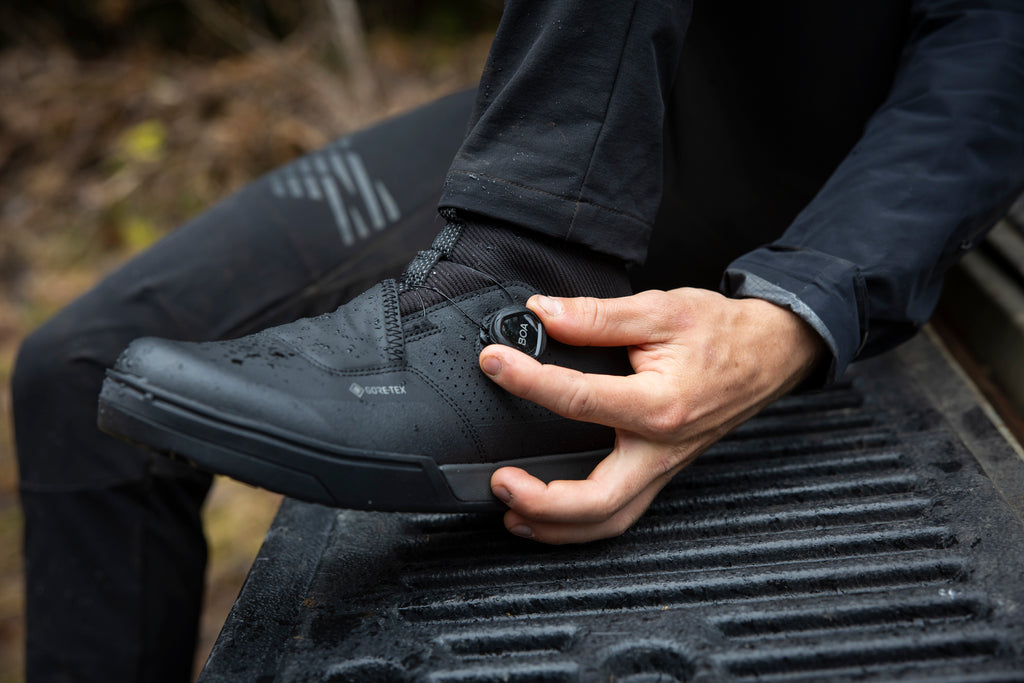By Amy Schlinger
If you’re purchasing a pair of bike shoes for the first time, you probably have a lot of questions. Do cycling shoes run true to size? Should they fit snug, or should you buy them with some room in case your feet swell from riding? What if you have wide feet—do they offer wide options? And what the heck is your European sizing? We know that it can be hard to make this first purchase, so we’re here to help answer all the key questions to help ensure your bike shoes fit well.
Do cycling shoes run true to size?
When deciding what size cycling shoes to get, go with your normal shoe size, as bike shoes run true to size. However, if you’re normally between sizes, for example sometimes you go with a 9 and sometimes a 9.5, it’s recommended that you size up. “Always size up if you have to decide between two sizes because your foot can swell throughout the day and your foot size changes,” says Jessie Gascon, Shimano’s lifestyle gear product manager. “We recommend trying on shoes and doing shoe fittings in the afternoon for this exact reason.” Even hydration throughout the day can affect the size of your feet. Plus, unless you’re planning on racing, having a little extra room in your shoe won’t affect your riding.
Should cycling shoes fit snug?
While it’s suggested to size up if you’re between sizes, cycling shoes are intended to wrap snuggly around the foot. Similar to how running or walking shoes are created to help you excel at said activities, cycling shoes were also designed with a specific purpose in mind—pedaling. “Cycling shoes are made to be used 99.9 percent of the time solely for pedaling—you’re not out and about walking or running around in them,” explains Gascon. Unlike high impact running, when you pedal, you’re applying pressure to the ball of the foot versus the toe area, so it’s low impact, and it doesn’t cause the foot to move around. “Therefore they are designed to fit very close to the foot, almost like a second sock,” says Gascon.” This helps to minimize foot movement and create more stability.
Shimano has taken over a million impressions of different foot shapes and has a good idea as to where the mass population fall, which has allowed them to build 12 foot-shaped lasts that they use to create their shoes. Most other cycling brands use only three or four lasts for all their shoes.

Do cycling shoes come in wide sizes?
Yes, some brands offer wide options in their cycling shoes. Shimano offers the following shoes in wide options.
Mountain Biking:
Gravel:
Road:
While there isn’t a specific “wide” option for the indoor line, the IC lineup has a lot of elasticity built into the upper design. This doesn’t mean the shoes will stretch out over time, but it does mean they can stretch to fit a wider food, but while retaining its shape over time. The Shimano RC3 Wide is a great option for a wide foot and is compatible with Delta / 3-Hole cleat systems.
Can you explain European sizing, and why are most cycling shoes sized this way?
Cycling originated in Europe, so European sizing is the universal standard across the industry. The best way to figure out your size is use the bike brand’s conversion chart. Below is Shimano’s sizing conversion chart.

What’s with the circular BOA adjustable dial?
The BOA adjustment on Shimano cycling shoes (and some other cycling brand’s shoes, too), allows you to get the most secure and comfortable fit possible. “You can crank down the dial in micro adjustments around the metatarsal area,” explains John Geary, manager of business development at Shimano. “And if you need to make an adjustment while riding, it’s very easy to do so with this technology.”

Where should I attach my cleats for the most comfortable riding?
Cleats in general have a little bit of a margin for error, which is also called “float.” Float refers to the back-and-forth movement, or the amount that you’re able to point your toes left or right while you’re clipped in. Shimano’s SPD pedals have 4-degrees of float, so you’re never locked into just one position. (Shimano’s SPD-SL cleats have three float options, one that has six degrees of float).
“The majority of the population has about five degrees of external rotation when they pedal,” says Chris Jacobson, North American brand manager for bikefitting.com and PRO bike gear. Translation: most people pedal slightly duck-footed. “So if you point the cleat between your first big toe and your second toe when you attach it, this will accommodate for that external rotation.”

The worst-case scenario is that you might experience some medial or lateral knee pain, in which case you can adjust the cleat. “The gold standard is to decide where you want to rotate your foot, moving your heel in towards the bike or away from the bike,” says Jacobson. “Then adjust your cleat in the opposite direction of where you want the heel to be.” Try just one adjustment. If you’re still having issues, Jacobson recommends getting help from a bike fitter.










